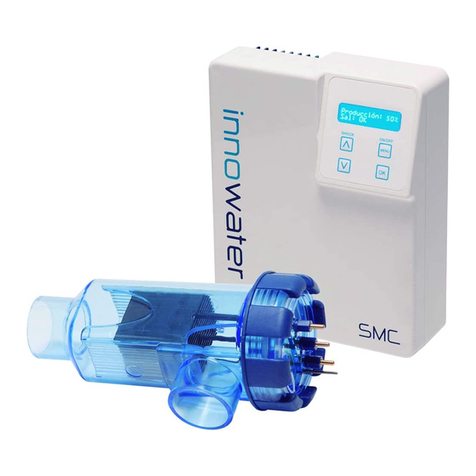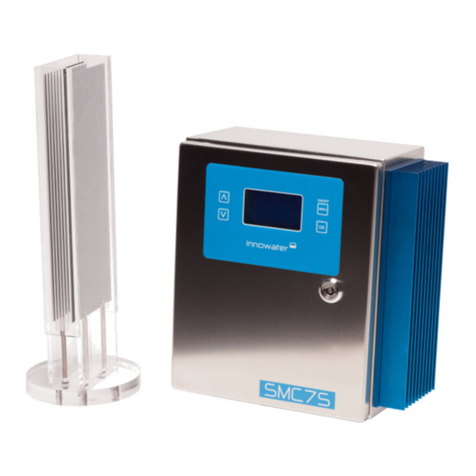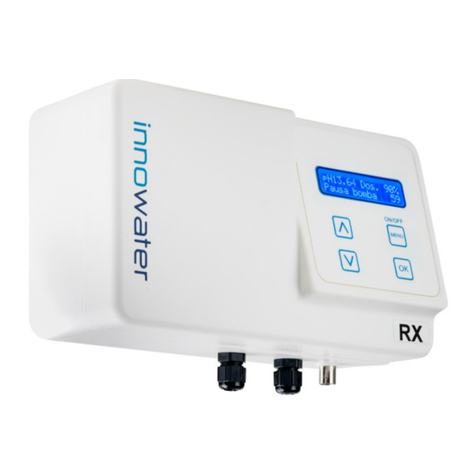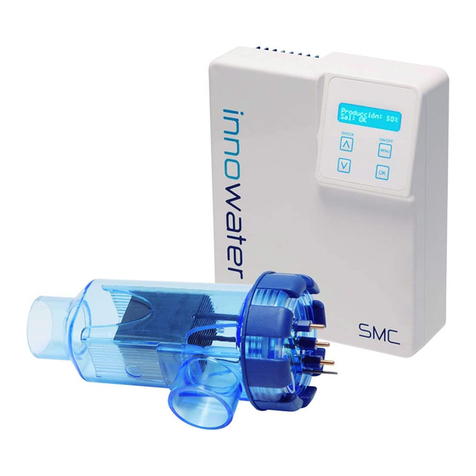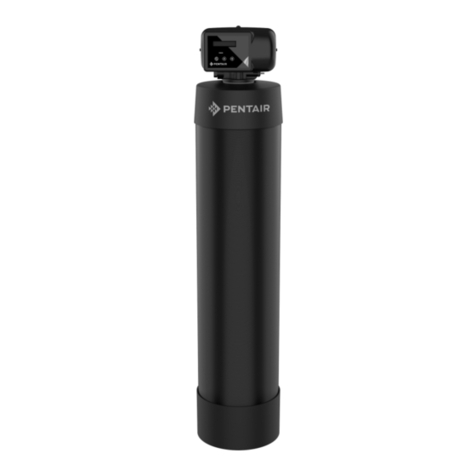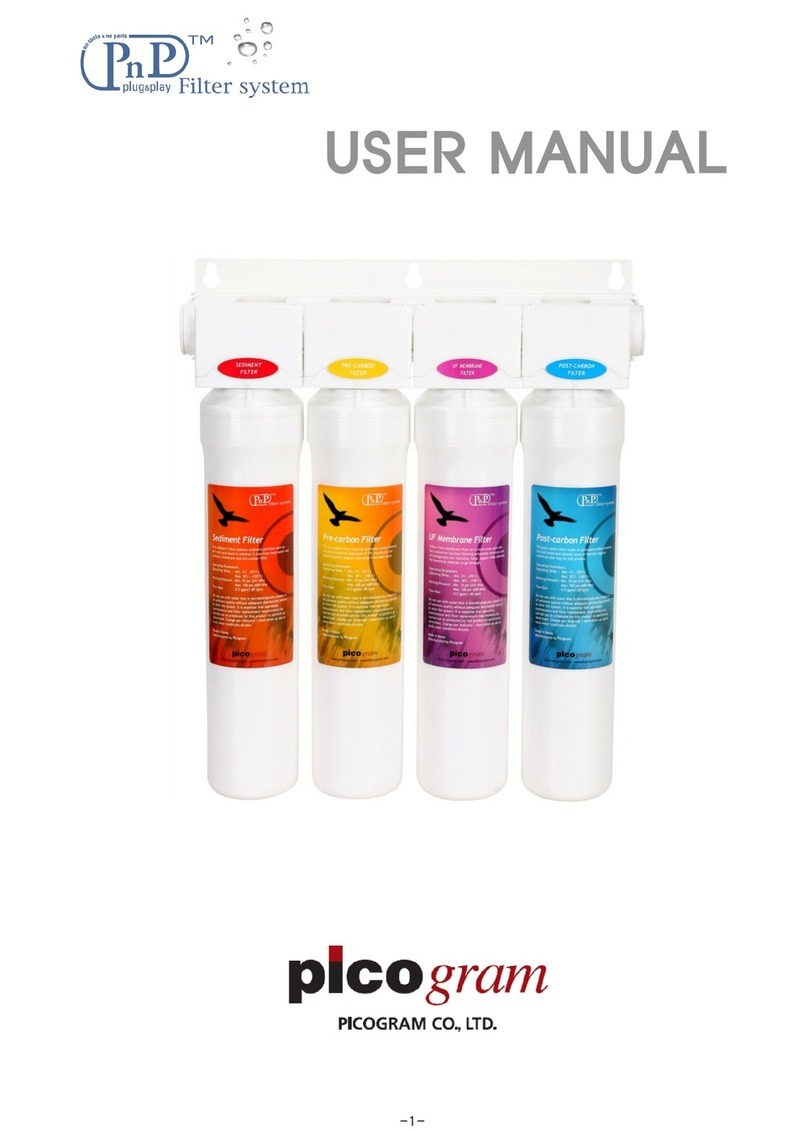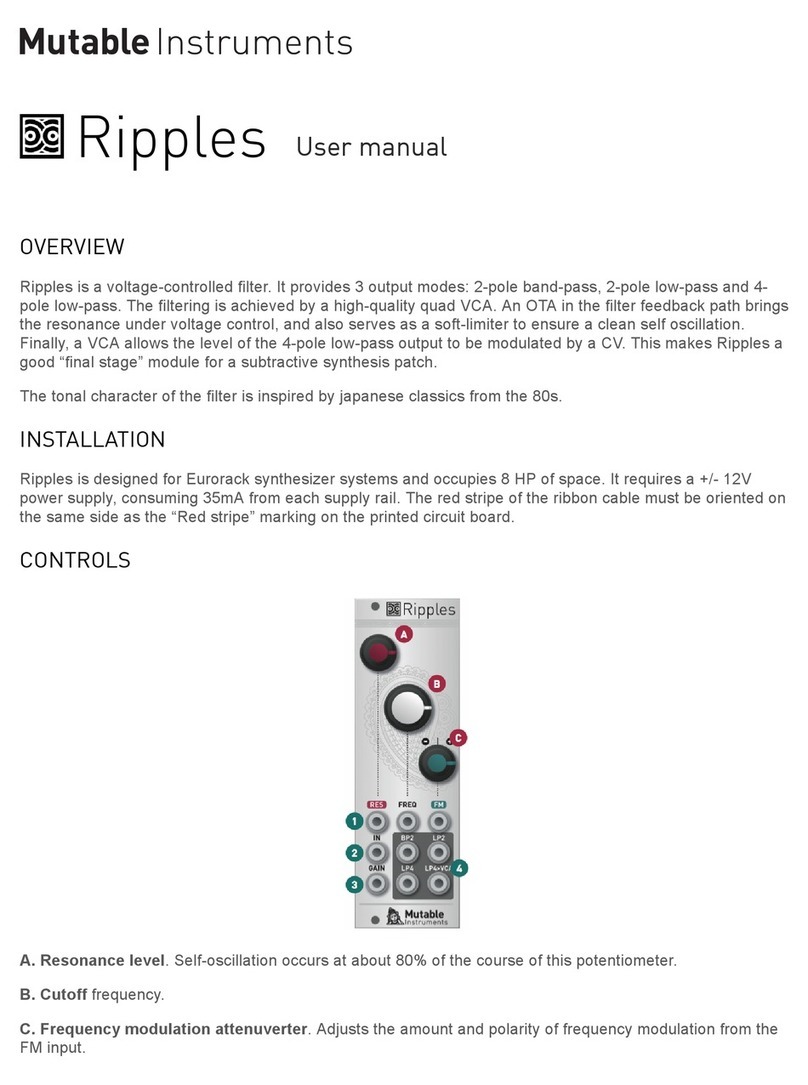Innowater SMC50 User manual

1 SMC
E
S
P
A
Ñ
O
L
Manual
SMC50

SMC 2
Página
1 Introducción ………………………………………………..………… 3
2 Descripción del aparato ……………………………...………… 4
3 Instalación …………………………………………………..………… 5
4 Preparación del agua …………………………………..………… 7
5 Adición de la sal ………………………………………….….……… 8
6 Operación …………………………………………………….………… 9
7 Recomendaciones y advertencias …………………...…… 12
8 Limpieza manual de la célula ……………………..………… 13
9 Garantía, servicio postventa
y piezas de repuesto ………………………………..…………… 14
10 Características técnicas ………………………………….…… 15
Reservados todos los derechos
31 SMC
E
N
G
L
I
S
H
SMC50
Maximum flow lt/min 600
Máximum pressure bar 4
Pressure drop kpa 5
Chlorine production gr/h 50
Max. output voltage VDC 24
Max. Output current ADC 7,5
Cell configuration Bipolar
Recommended salt
concentration gr/l 4-35
Cell housing material PC
Cell life span h 14.000
Electrode substrate material Titanio
grado 1
Maximum swimming pool size m3
- Temperate climate 30
- Tropical climate 20
Power supply VAC 230
Power consumption W 190
Weight Kg 13
10. TECHNICAL CHARACTERISTICS

SMC 30
9. WARRANTY, TECHNICAL SERVICE AND SPARE PARTS
Warranty
1. The electrolytic cell and the control board will be guaranteed for 3 years against
any manufacturing defect. The cell is a consumable part whose wear depends on
the operating conditions and is not covered by the warranty.
2. The manufacturer declines any responsibility in the following cases:
a. If the instructions in this manual are not followed
b. Faulty electrical connections
c. Accidental damage
d. Damage due to water in the control board
e. Pump of more than 1.5 V power without installation of a “By-
Pass” (according to assembly diagram on page 21)
f. If acids are poured into the skimmers or cell without having
disconnected the rectifier.
g. Placement of an acid tank near the chlorinator with insufficient
ventilation.
h. Operation with calcium build up on the electrodes.
3. The chlorinator shipping cost will be paid by the client/distributor.
4. It should be clarified that the Innowater chlorinator installation is completely
independent from the filtration equipment, pump or multi-valve. All they have in
common is the connection to filtration timer.
Spare parts
Innowater S.L. or its distributor have spare parts at your disposal. The use of non-
original parts or the manipulation of the equipment by personnel not authorised by
Innowater may cause serious problems to your chlorinator and will cancel the
warranty.
3 SMC
E
S
P
A
Ñ
O
L
1. INTRODUCCIÓN
Le agradecemos la confianza que ha depositado en nosotros con la adquisición de
su clorador Innowater. Los cloradores SMC han sido fabricados siguiendo el más
estricto control de calidad y utilizan la tecnología más avanzada en electrolisis
salina, fruto de nuestra experiencia e investigación durante más de 20 años.
Con un mínimo de mantenimiento y un respeto de las normas elementales de
instalación y utilización usted disfrutará de un aparato extremadamente eficaz
durante muchos años.
Le rogamos que lea atentamente este manual antes de su instalación o puesta en
marcha y que lo conserve para futuras referencias.
Los apartados que conciernen a la instalación suponen conocimientos de electricidad
y de instalación de piscinas. Le aconsejamos que recurra a un profesional.
Ponga especial atención en los puntos marcados con el siguiente símbolo:
Los daños causados al aparato por no respetar estas precauciones pueden
suponer la anulación de la garantía.

SMC 4
2. DESCRIPCIÓN
1 Cuadro de mando
a Pantalla LCD
b Teclado
c Cables y conectores de célula
2 Cable de alimentación 230 VAC
3 Célula electrolítica
4 Vaso de la célula
5 Junta tórica
6 Anillo de cierre
1
b
3
6
2
a
c
5
4
29 SMC
E
N
G
L
I
S
H
8. MANUAL CELL CLEANING
Your SMC chlorinator is provided with a self-cleaning polarity change system that in
normal conditions eliminates maintenance work. However, in exceptional cases,
when the calcium concentration is very high (very hard water), polarity change may
not be enough to completely eliminate the calcium build up. Visually inspect the cell
regularly to detect the presence of calcium and, if necessary, clean the cell. Let the
cell dry completely during one or more days for the calcium build up to detach by
itself. You can help this by slightly knocking the cell but do not introduce any
element that could scratch the electrodes. Their coating is fragile. You can also use
a water jet. DO NOT USE ANY METALLIC OR STABBING ELEMENT TO SCRATCH THE
ELECTRODES.
If you are not able to remove the calcium build up in the way described, proceed as
follows:
1 Turn off the pump and the chlorinator.
2 Disconnect the cables of the cell, remove the thread lock and extract the cell.
3 Immerse the electrodes in a hydrochloric acid solution made from 1 part of acid
(HCl 30%) and 9 parts of water. Do not immerse the rods or the cap of the cell. The
hydrochloric acid will react with the calcium and will dissolve it producing gas.
4 As soon as the calcium build up dissolves, rinse the cell immediately with
freshwater, dry the terminal area properly and reinstall the cell in its housing.
Never leave the cell in the acid solution for more than 5 min. Do
not scratch the electrodes with metal objects. For safety reasons,
always add the acid into the water and never inversely.

SMC 28
7. RECOMMENDATIONS AND WARNINGS
The bipolar cells of your SMC chlorinator have been manufactured using an
exclusive technique and rigorous quality controls conferring extraordinary duration
and resistance. However, there are several factors that may irreversibly reduce the
properties of any electrode that you should avoid in order to obtain the best
performance and longest lifespan of your chlorinator. These are:
- Operating with calcium buildup on the electrodes
- Excessive chlorine concentration (chlorine is corrosive above 3.0 ppm)
- pH too low or too high
- Insufficient salt concentration
- Water temperature below 10 ºC
- Adding salt to the pool with the chlorinator working
- pH corrector acid injection before the cell housing, in the
skimmers or in the bottom drain inlet
We recommend you to periodically check the cell for calcium buildup, corrosion or
leakage. The rods insulation and top sealing must be in perfect condition. If
there is any damaged please send the cell to the technical service for diagnosis or
replacement.
NEVER operate the chlorinator if:
- Your installation is not provided with a residual current circuit breaker
- Water is not flowing through the cell
- Valves are closed
- The filter is being cleaned
- The swimming pool is being emptied
- The water temperature is below 10º C
- There is calcium build up on the electrodes
5 SMC
E
S
P
A
Ñ
O
L
3. INSTALACIÓN
Cuadro de mando
Fije el cuadro de mando utilizando el soporte y los tornillos suministrados en un
lugar de fácil acceso y lectura. El cuadro de mando deberá situarse a 1,5 metros
como máximo de la célula electrolítica. Elija un lugar bien ventilado y protegido de
posibles inundaciones y salpicaduras de agua.
Asegúrese de que la instalación está protegida por un interruptor
diferencial. Esto es imperativo legal y es fundamental para su
seguridad.
Conecte el hilo de tierra (amarillo y verde) del extremo del cable de alimentación a
la tierra del cuadro eléctrico de la piscina. Conecte la fase (marrón) y el neutro
(azul) a una salida 230 VAC del contactor de la bomba de forma que el clorador sea
alimentado cuando se enciende la bomba. Conecte los cables del clorador en
contactos libres. No utilice los contactos ocupados por el cable de la bomba.
Esto evitará que, al desconectarse el contactor, el clorador quede unido
eléctricamente a la bomba, lo que podría ocasionar daños graves. Compruebe que
el clorador se apaga cuando la bomba se para. Esta operación debe ser efectuada
por un profesional.
El clorador debe recibir 230 VAC sólo cuando la bomba está en
marcha y el agua circula por la célula. Ponga especial atención a la
conexión si su instalación es trifásica (bomba a 380 VAC)
Vaso de célula
El vaso de célula debe ser instalado en el retorno del agua a la piscina. Debe ser el
último elemento por el que pasa el agua antes de volver a la piscina: siempre
después del filtro y, en su caso, de la bomba de calor, paneles solares etc. Utilice
pegamento para PVC rígido y espere a que se haya secado completamente antes
de introducir la célula.

SMC 6
Si ha instalado un sistema de regulación automática de pH, la
inyección del ácido debe realizarse imperativamente después
del vaso. De lo contrario los electrodos de la célula sufrirían una
fuerte corrosión al contacto con el ácido y su garantía quedaría
anulada. El bidón de ácido debe situarse alejado del clorador y,
si está instalado en un local enterrado, fuera de éste. De lo
contrario los vapores corrosivos dañarán el clorador y cualquier
otro material eléctrico que tenga en la instalación.
Cuando sea posible, se recomienda la instalación en by-pass con tres válvulas.
Esta disposición permite ajustar la cantidad de agua que circula por la célula y
poder desmontar la célula sin dejar de utilizar la depuradora. En cualquier caso,
cuando se dispone de una bomba de cierta potencia, el by-pass es necesario
para reducir el caudal de agua a su paso por la célula y evitar vibraciones y
presión excesiva en los electrodos.
Puede instalar el vaso vertical u horizontalmente, según las posibilidades de su
local técnico, si bien la posición vertical es la más recomendable. Esta posición
permite, además, la retirada de la célula sin derramar agua. Prevea suficiente
espacio para poder extraer la célula una vez que haya instalado el vaso.
No instale nunca la célula con la entrada de agua lateral
mirando hacia arriba.
27 SMC
E
N
G
L
I
S
H
This screen appears when the salt concentration in the water is too low to prevent
cell damage. Add enough salt (5 to 6 kg/m³) and wait until the salt is completely
dissolved. Then press OK to restart the chlorinator. This screen can also be
displayed if the water temperature is too low, if there is a bad electrical connection
between the control unit and the cell or if there is calcium built up on the
electrodes.
This screen appears when the control unit does not detect a cell connected to it.
Make sure the cell is well connected and press OK to restart.
SALT TOO
LOW
CELL NOT
DETECTED

SMC 26
Use the Λ or V buttons to select the period and then press OK to confirm and save
the setting. Then press MENU once or more to return to the Production Screen.
You can also exit without saving the setting by pressing MENU.
When a polarity change is taking place the unit will
enter in pause mode during 10 minutes. This will be
indicated by the screen on the left showing the
remaining pause time.
3. T V I readings
This menu allows you to read the temperature
inside the control unit, the voltage applied to the
cell and the current passing through it. These
parameters can be very useful when servicing or
diagnosing.
4. LCD contrast
Go to the MENU 6 LCD contrast and press OK
Adjust the LCD contrast using the Λ V keys.
Press OK to save and exit.
5. Fault messages
This screen is displayed when the probe detects no water and the control system
stops the production. Verify that there is water in the cell and that its level reaches
the top where the probe is located. A low water level can result from operating the
chlorinator with the pump not working. In this case switch off the chlorinator
immediately.
THE CHLORINATOR SHOULD NEVER BE POWERED IF THE PUMP IS NOT
WORKING OR IF THE WATER IS NOT FLOWING SUFFICIENTLY. THE
CHLORINATOR POWER SUPPLY SHOULD DEPEND ON THE PUMP POWER
SUPPLY.
A low water level in the cell may also be due to a dirty filter, an obstructed circuit
or to a pump not powerful enough. As soon as the water level is restored the fault
disappears.
Chang. polarity
remaining: 8 min
LOW WATER
LEVEL IN CELL
MAIN MENU
4 T V I readings
T= 29.8ºC
V= 23.40V I=3.4A
MAIN MENU
6 LCD contrast
LCD contrast
- ■ ■ ■ ■ ■ ■ +
7 SMC
E
S
P
A
Ñ
O
L
Célula
Introduzca la célula en el vaso. LA ABERTURA LATERAL DEBE COINCIDIR CON
LA ENTRADA DE AGUA DEL VASO. Asegúrese de que la junta se encuentra en su
lugar y coloque la rosca. A continuación, conecte el cable de la célula en los bornes
de la célula. .
NOTA: Los bornes de la célula deben ser apretados moderadamente y siempre a
mano. No utilice nunca una herramienta porque podría dañar la célula. La
estanqueidad de la célula está asegurada por el sellado interior.
Una buena filtración es fundamental para la cloración salina.
Verifique que el filtro y sus elementos filtrantes están en óptimas
condiciones de trabajo.

SMC 8
4. PREPARACIÓN DEL AGUA
Utilice preferentemente agua de la red urbana. Si utiliza agua de origen distinto
hágala analizar primero y verifique que no existe ninguna contraindicación para la
electrólisis salina (como, por ejemplo, una concentración elevada de metales o cal).
Compruebe también que el agua es conforme a las normas sanitarias.
Equilibre el agua antes de poner en funcionamiento su clorador y añada
estabilizador en la cantidad prescrita por el fabricante (normalmente 1 kg por cada
25m3 de agua). No añada demasiado estabilizador porque bloqueará la acción
desinfectante del cloro.
NOTA : El estabilizador impide la desintegración del cloro debida a los rayos UV. La
ausencia de estabilizador puede dificultar la obtención de un residual de cloro en
horas de máxima insolación y le obligará a producir más cloro inútilmente
reduciendo la vida de la célula. En general, y especialmente si no tiene
estabilizador, le recomendamos clorar durante las horas en que no hay sol.
El agua debe estar limpia y clara y presentar los siguientes parámetros:
Sal ………………………... 5-6 kg/m3 (gr/l)
pH …………………………. 7,2-7,6 (cemento) 6,8-7,0 (poliéster)
TAC ……………………….. 60-100 ppm
TH …………………………. 15-20º Franceses
Estabilizador ………... 20-30 ppm (o según indicación del fabricante)
Temperatura ……….. >10 º C
25 SMC
E
N
G
L
I
S
H
If you want to quit the Shock mode press any key. The following screen will be
displayed:
Press OK to exit the shock mode or MENU to
continue the shock treatment.
1 Language setting
From the Production Screen press MENU. The following screen will appear:
Press OK to enter the Language menu.
Choose a language using he arrows Λ V and
confirm by pressing OK. Press MENU to return back
to the production screen.
2 Polarity period setting
The polarity applied to the cell is periodically reversed to remove calcium built-up.
The factory pre-programmed period is 8 hours. Depending on the conditions of your
pool it may be necessary to reduce this period in order to increase the frequency of
cleaning. Note that the shorter the period, the shorter the cell life span. A
period of less than 4 hours will drastically reduce the life of the cell. Inversely, you
should increase this period if your cell don’t need to be cleaned that frequently. We
recommend, in general, to set this period to the larger number of hours as long as
there is not calcium build-up on the electrodes.
To change the polarity period, go to the Production Screen and press MENU. The
following screen will appear:
Press the Λ or V buttons until you reach the menu 2
Polarity period as shown in the following screen:
Press OK. The following screen will be displayed:
Cancel Shock?
YES:OK NO:MENU
MAIN MENU
1 Language
Choose language
English
MAIN MENU
2 Polarity per.
Polarity 7h
Select period
SHOCK 7 h
Remaining: 07:00
MAIN MENU
1 Language

SMC 24
6. OPERATION
The chlorinator and its different menus are controlled with a four key keypad. The
keys Λ and MENU also have a secondary function (SHOCK and ON/OFF
respectively) accessible by holding down the key for 2 seconds.
NOTE: At some points of activity or during a change of function the keyboard may
seem as it is not responding immediately. This is completely normal. Just wait a few
seconds for the task to be completed and the display will respond.
6.1 ON/OFF
The ON/OFF function (MENU key + 2 seconds) turns the chlorinator alternatively
ON and OFF. Once switched on, the Production Screen will appear:
This screen indicates the current production rate and the existing salt level in the
water. It may take a few seconds for the salt level to appear. If you are on a
different screen you can always come back to the production screen by pressing the
MENU button repeatedly.
To increase or decrease the chlorine production rate press the Λ or V arrows. The
chlorinator modules the production by varying the operating time in periods of 10
minutes. At 100% the chlorinator works constantly.
You will soon get to know the needs of your pool which will depend on the different
conditions (number of users, temperature, etc.) allowing you to anticipate in the
production setting. In general, to enjoy the benefits of salt water chlorination, we
recommend setting the minimum production rate that produces a crystal clear water
in your pool. Avoid chlorinating during high sunshine hours because chlorine will
quickly disappear due to the UV radiation and won’t have the time to disinfect your
pool thoroughly. We recommend to program the chlorinator during the night or at
low sunshine hours.
Shock Mode
The shock mode allows you to apply a shock treatment (chlorinator at 100%) for a
selectable period of time with automatic return to the previous production rate once
the shock period has ended. This feature is useful if the chlorine level has fallen
suddenly for some reason and you want to recover it quickly.
To activate the shock mode, go to the Production Screen and press Λ (SHOCK) for
a few seconds. The following screen will appear:
Select a number of hours, by using the Λ or V arrows and press OK to accept or
MENU to exit. If you click OK, you will enter into the Shock mode and the following
screen will be displayed:
OFF
Production: 70%
Salt: OK
Shock 7 h
Select duration
9 SMC
E
S
P
A
Ñ
O
L
5. ADICIÓN DE LA SAL
El clorador debe permanecer totalmente desconectado durante
esta operación y hasta que la sal se encuentre completamente
disuelta. El funcionamiento del clorador con sal sin disolver podría
dañar irreversiblemente la célula y la fuente de alimentación y la
garantía quedaría anulada.
Calcule el volumen de la piscina y vierta de 5 a 6 kg de sal por metro cúbico.
Asegúrese de que el clorador está desconectado y haga funcionar la depuradora
durante al menos 24 horas antes de conectar el clorador.
Si su piscina es de cemento y acaba de ser construida espere al
menos cuatro semanas de curado antes de verter la sal.
Puede acelerar el proceso de disolución de la sal utilizando el limpia fondos.
Compruebe con un kit de medida del comercio que la concentración de sal se
encuentra entre 5 y 6 kg/m3.
El funcionamiento del clorador no conlleva ningún consumo de sal. Con el tiempo,
sin embargo, la concentración de sal puede verse reducida a causa de la lluvia o de
otros aportes de agua dulce (relleno, lavado del filtro). Cuando tenga que corregir
la concentración de sal, vierta la sal lo más cerca posible de los impulsores. Nunca
en los skimmers o en el sumidero.

SMC 10
6. OPERACIÓN
El clorador y sus diferentes menús se controlan mediante un teclado de cuatro
teclas. Las teclas Λ y MENU tienen una segunda función (SHOCK y ON/OFF
respectivamente) a la que se accede manteniendo la tecla pulsada durante 2
segundos.
NOTA: En algunos momentos de la actividad del clorador puede que el teclado no
responda inmediatamente y la pantalla tarde unos segundos en responder. Esto es
completamente normal.
6.1 ON/OFF
La tecla ON/OFF (tecla MENU + 2 segundos) apaga y enciende alternativamente
el clorador. Una vez en ON se mostrará la Pantalla de Producción:
En ella se indica el nivel de producción actual y el nivel de sal existente. El nivel de
sal puede tardar en aparecer unos segundos. Si se encuentra en otra pantalla
puede siempre volver a la Pantalla de Producción pulsando varias veces la tecla
MENU.
Para aumentar o disminuir el porcentaje de producción pulse las flechas Λ o V. El
clorador modulará la producción variando el tiempo de funcionamiento en periodos
de 10 minutos. Al 100% el clorador trabaja en continuo.
En principio, usted no tardará en conocer las necesidades de su piscina en función
de las distintas condiciones (número de bañistas, temperatura, etc.) lo que le
permitirá anticiparse en el ajuste de producción. En general, para disfrutar de las
ventajas de la cloración salina, le recomendamos que ajuste la producción al
mínimo porcentaje que produzca un agua limpia y cristalina en su piscina. Evite
clorar durante las horas de mayor insolación porque el cloro generado desaparecerá
rápidamente con los rayos UV y no tendrá tiempo para desinfectar su piscina en
profundidad. Le recomendamos programar la depuradora por la noche o durante las
horas de baja insolación.
6.2 Modo Shock
La función Shock le permite aplicar un tratamiento de choque (clorador al 100%)
durante un número de horas y que el clorador vuelva a su estado de producción
anterior sin necesidad de que vuelva a ajustarlo. Esta función es útil si el nivel de
cloro ha disminuido bruscamente debido a alguna causa y quiere recuperarlo
rápidamente.
Para activar la función shock debe estar en la Pantalla de Producción y pulsar la
tecla Λ (SHOCK) durante unos segundos. Aparecerá la siguiente pantalla:
Seleccione un número de horas, mediante las teclas Λ
V y pulse OK para aceptar o MENU para salir. Si pulsa
OK, el Clorador entrará en modo Shock y mostrará la
siguiente pantalla:
OFF
Produccion: 70%
Sal: OK
Shock 7 horas
Selecc. duracion
23 SMC
E
N
G
L
I
S
H
4. WATER PREPARATION
Use preferably water from the metropolitan network. If water from a different origin
is used, analyze it to verify that there is no contraindication regarding salt
electrolysis (such as a high concentration of metals or calcium, for example). Make
also sure the water complies with health standards.
Balance the water before starting your chlorinator and add the amount of chlorine
stabilizer prescribed by the manufacturer (normally 1 kg per 25 m3 of water). Do
not exceed the dose because this will block the disinfection action of the chlorine.
NOTE : Stabilizer prevents the disintegration of chlorine due to UV radiation. A lack
of stabilizer could make it difficult to reach a chlorine residual concentration during
high sunshine periods and will force the chlorinator to increase production reducing
the life span of your cell. In general, and specially if you don't use stabilizer, we
recommend to chlorinate during low sunshine hours.
The water must be clean and clear, presenting the following parameters:
Salt 5-6 kg/m3 (gr/l)
pH 7,2-7,6 (cement) 6,8-7,0 (polyester)
TAC 60-100 ppm
TH 15-20º French
Stabilizer 20-30 ppm (or according to the indications
by the manufacturer)
Temperature >10 º C
5. ADDING SALT
The chlorinator must remain totally disconnected during this
operation and until the salt is completely dissolved. Operating the
chlorinator with non dissolved salt could irreversibly damage the
cell and the power supply, and lead to a cancellation of the
warranty.
Calculate the volume of the swimming pool and add 5 to 6 Kg of salt per cubic
meter. Make sure the chlorinator is disconnected and make the filtration system
work for at least 24 hours.
If you have a cement pool just built, let it cure for at least four
weeks before adding salt.
The salt dissolving process can be accelerated using the pool cleaner. Check the salt
concentration is between 5 and 6 kg/m3 using a kit from a specialized pool shop.
The salt chlorination process does not consume salt. However, the salt
concentration may be reduced over time due to the rain or other periodic freshwater
contributions (filling up, filter cleaning, etc.). Whenever the salt concentration needs
to be corrected, pour salt as close as possible to the return lines. Never pour salt in
the skimmers or in the drain inlet.

SMC 22
Cell
Insert the cell in the cell housing making sure that its open side window is
pointing to the side water inlet. Make sure the O-ring is fitted correctly and
tighten the thread. Then, connect the cell cable connector to the cell terminals.
Verify that the connector is orientated so that its small hole is aligned with the thin
pin on the cell before trying to plug the connector.
NOTA: The cell pins should only be tighten slightly and always by hand. Never use
a tool because the cell could be damaged. Water tightness is assured by the internal
seal.
A good filtration is essential in salt chlorination. Please, verify that
your filter and filtrating material are in optimal working
conditions.
Thread lock
Cell O-ring
Open side window
must face to the
side water inlet
11 SMC
E
S
P
A
Ñ
O
L
Para abandonar el modo Shock pulse cualquier tecla.
Aparecerá la pantalla de la izquierda. Pulse OK para
abandonar la función shock o MENU para volver a
ella.
6.3 Menús
Para acceder a los diferentes menús, pulse la tecla MENU desde la Pantalla de
Producción. Aparecerá la siguiente pantalla:
Desplácese a continuación con las flechas Λ o V
hasta el menú deseado y pulse OK para acceder a él.
Para regresar a la Pantalla de Producción pulse la
tecla MENU varias veces.
6.3.1 MENU PRINCIPAL - 1 Idioma
Desplácese con la flechas Λ V hasta encontrar el
idioma deseado y pulse OK. Vuelva a pulsar MENU
para regresar a la Pantalla de Producción.
6.3.2 MENU PRINCIPAL - 2 Periodo de polaridad
La polaridad aplicada a la célula se invierte periódicamente para desincrustar
posibles depósitos de cal. La programación de fábrica es cada 8 horas. Dependiendo
de las condiciones de su piscina puede ser necesario disminuir este periodo para
aumentar la frecuencia de limpiado. Tenga en cuenta que cuanto menor sea
este periodo menor será la duración de su célula (un periodo de menos de 4
horas la reducirá drásticamente). Inversamente, puede que su piscina necesite una
frecuencia menor de limpieza y puede aumentar el periodo de fábrica. Le
recomendamos ajustar siempre este periodo al mayor número de horas posible
mientras no observe incrustaciones calcáreas en la célula.
Seleccione el periodo de polaridad mediante las
flechas Λ ó V y pulse OK para confirmar y guardar el
valor o bien MENU para salir.
Cuando se produce el cambio de polaridad el aparato
entra en modo de espera durante unos 10 minutos.
Esto se indicará con la pantalla de la izquierda en la
que se muestra el tiempo de espera restante.
SHOCK 7 horas
Quedan: 07:00
Anular Shock?
SI:OK NO:MENU
MENU PRINCIPAL
1 Idioma
Elija idioma
Español
Selecc. periodo
polaridad 8 h.
Cambio polaridad
Espere 06:30

SMC 12
6.3.3 MENU PRINCIPAL - 3 Valores T V I
Este menú visualiza la temperatura en la unidad de
control y el voltaje e intensidad en la célula. Estos
parámetros pueden ser muy útiles para diagnóstico.
6.3.4 MENU PRINCIPAL - 4 Contraste LCD
Ajuste el contraste mediante las teclas Λ V y pulse
OK para confirmar.
6.4. Mensajes de fallo
Esta pantalla aparece cuando la sonda no detecta agua y el sistema de control
detiene la producción. Verifique que existe agua en la célula y que su nivel llega
hasta la parte superior donde se encuentra la sonda. Un nivel bajo puede producirse
por hacer funcionar el clorador sin que la bomba esté funcionando en cuyo caso ha
de apagarse el clorador inmediatamente.
EL CLORADOR NO DEBE FUNCIONAR NUNCA SI LA BOMBA NO
FUNCIONA O SI EL AGUA NO CIRCULA SUFICIENTEMENTE. SU
ALIMENTACION ELECTRICA DEBE DEPENDER DE LA MARCHA DE LA
BOMBA. VER PAGINA 5.
Un nivel bajo de agua en la célula puede también ser debido a un filtro sucio, una
obstrucción en el circuito o a una bomba de potencia insuficiente. Tan pronto como
el nivel de agua se restituye desaparece el fallo.
Esta pantalla aparece cuando la concentración de sal en el agua es demasiado baja
y el clorador detiene la producción para evitar daños en la célula. Añada sal en
suficiente cantidad (de 5 a 6 kg/m³) y cuando se haya disuelto completamente
pulse la tecla OK para reiniciar el aparato.
Esta pantalla puede también aparecer si la temperatura del agua es excesivamente
baja, si hay una mala conexión eléctrica entre el cuadro de mando y la célula o si
existen depósitos de cal en los electrodos.
T= 30,3ºC
V=23,40V I=3,20A
Ajuste contraste
- ■ ■ ■ ■ +
NIVEL BAJO DE
AGUA EN CELULA
NIVEL DE SAL
INSUFICIENTE
21 SMC
E
N
G
L
I
S
H
If an automatic pH regulation system has been installed, the
injection of the product must take place unconditionally after the
cell. Otherwise, the electrodes will corrode due to the acid
contact and the warranty will be cancelled. Place the acid tank
far from the chlorinator and outside the pump room if you have a
covered in-ground pump room. Otherwise the corrosive vapor
will rust any electronic component quickly.
Whenever it is possible, a by-pass installation with three valves is always
recommended. This allows the amount of water flowing through the cell to be
adjusted and the swimming pool to work with the cell housing disassembled. In any
case, when there is a pump with certain power, the by-pass is required to reduce
the speed of water through the cell housing to lower the pressure and avoid
vibrations.
Although the vertical position is recommended, the cell housing may be installed
vertically or horizontally, according to the characteristics of your site. In the vertical
position, however, the cell housing can be opened without water spillage. Provide
enough room to extract the cell once the housing has been installed.
NEVER INSTALL THE CELL WITH ITS SIDE WATER INLET FACING
UPWARDS

SMC 20
Control Unit
Install the control unit on a wall using the bracket and the screws supplied.
Choose a place for easy access and reading. The control unit must be placed at
1.5 meters max. away from the electrolytic cell. Choose a place with good
ventilation and protected from possible flooding, rain, water leaks or splash.
Please, make sure that a residual current circuit breaker protects
the installation. This is a legal requirement and very important
for your safety.
Connect the earth wire (yellow and green) of the 230 VAC power supply cable to
the earth of the swimming pool electric panel. Connect the phase (brown) and
the neutral (blue) to the output contacts of the pump contactor in such a way
that the chlorinator will be powered only when the pump is working. Connect the
chlorinator wires to non occupied contacts. Do not use the contacts in use by
the pump. This will prevent the chlorinator to be electrically connected to the
pump when the contactor is switched off what could cause serious damage. Verify
that the chlorinator switches off itself when the pump stops. This operation
should be performed by a professional.
The chlorinator should be powered to 230 VAC only if the pump is
working and the water is flowing through the cell. Please pay
special attention if your installation is three-phase (380 VAC
pump)
Cell housing
The cell housing must be installed in the return flow to the swimming pool and as
the last element the water goes through before returning to the pool: always
after the filter and any the heat pumps, solar panels, etc. Use special glue for
rigid PVC and wait until it completely dries before inserting the cell.
3 INSTALLATION
13 SMC
E
S
P
A
Ñ
O
L
7. RECOMENDACIONES Y ADVERTENCIAS
Las células bipolares de su clorador SMC han sido fabricadas utilizando una técnica
exclusiva y un riguroso control de calidad que les confiere una duración y
resistencia extraordinarias. No obstante, existen diversos factores que pueden
mermar irreversiblemente las propiedades de cualquier electrodo y que usted
deberá evitar a fin de obtener el mayor rendimiento y duración de su clorador.
Estos son:
- Funcionamiento con depósitos de cal en la superficie de los electrodos
- Concentración de cloro excesiva (el cloro es corrosivo por encima de 3.0 ppm)
- pH demasiado alto o bajo
- Ausencia de sal o concentración demasiado baja
- Temperatura del agua inferior a 10º C
- Vertido de la sal con clorador en marcha
- Inyección de ácido corrector de pH antes del vaso, en los skimmers o
sobre el sumidero de fondo.
Le recomendamos inspeccionar periódicamente la célula. El aislante que recubre
las varillas de los electrodos y el sellado superior deben estar en perfecto
estado. Si observa cualquier daño envíe la célula al servicio técnico para ser
examinada.
NO haga funcionar NUNCA el clorador si:
- Su instalación carece de interruptor diferencial
- No circula agua por la célula
- Las válvulas están cerradas
- Esta lavando el filtro
- Está vaciando la piscina
- El agua está a menos de 10º C
- Hay depósitos de cal sobre los electrodos

SMC 14
8. LIMPIEZA MANUAL DE LA CÉLULA
Su clorador SMC está dotado de un sistema de auto limpieza por cambio de
polaridad que elimina prácticamente el mantenimiento. No obstante, en casos
excepcionales cuando la concentración calcárea del agua es muy elevada (aguas
muy duras), el cambio de polaridad puede no ser suficiente para eliminar
completamente los depósitos calcáreos. Inspeccione visualmente la célula con
regularidad para detectar la presencia de cal y, si es necesario, limpie la célula. Lo
ideal es dejar secar la célula completamente durante uno o varios días para que se
desprendan las placas de cal por si solas. Puede ayudarlas golpeando ligeramente la
célula pero no introduzca ningún elemento que pueda rayar los electrodos ya que su
recubrimiento es delicado. Puede utilizar también agua a presión. No utilice
ningún elemento metálico o punzante para limpiar los electrodos.
Si le es imposible desprender la cal de esta forma, proceda como sigue:
1 Apague la bomba y el clorador.
2 Desconecte los cables de la célula, quite el aro de cierre y extraiga la célula.
3 Sumerja los electrodos en una solución compuesta por 1 parte de ácido
clorhídrico (HCl 30%) y 9 de agua. No sumerja las varillas ni la tapa donde se
encuentran los bornes. El ácido clorhídrico reaccionará con la cal disolviéndola y
produciendo gas.
4 Tan pronto como la cal se desprenda, aclare inmediatamente la célula con agua
dulce, seque bien el área de los bornes y vuelva a instalarla en el vaso.
No deje la célula nunca más de 5 min. en la solución ácida. No
rasque los electrodos con objetos metálicos. ATENCION: Vierta
siempre el ácido sobre el agua y nunca a la inversa.
19 SMC
E
N
G
L
I
S
H
2. SALT WATER CHLORINATOR DESCRIPTION
You will find the following items in your SMC box:
1 Control unit
a LCD screen
b Keyboard
c DC cell cable and connector
2 220 VAC power supply cable
3 Electrolytic cell
4 Cell housing
5 Cell O-ring
6 Thread lock
1
b
3
6
2
a
c
5
4

SMC 18
1. INTRODUCTION
We thank you for your purchase of an Innowater chlorinator. SMC chlorinators are
manufactured following the strictest quality controls and using the most advanced
technology of saltwater electrolysis resulting from our experience and research for
over 20 years.
Adopting a basic maintenance and following elementary rules for installation and
use, you will enjoy an extremely performing device for many years.
Please read this manual carefully before its installation or start-up, and keep it for
further reference.
The sections concerning the installation require electricity and swimming pool
installation knowledge. We recommend the installation by a professional.
Please pay special attention to the points marked with the following symbol:
Any damage caused to the chlorinator resulting from not complying with
these warnings may lead to cancellation of the warranty.
15 SMC
E
S
P
A
Ñ
O
L
9. GARANTÍA, SERVICIO POST-VENTA Y PIEZAS DE REPUESTO
Garantía y servicio postventa
1. La célula electrolítica y el cuadro de mandos tienen 3 años de garantía contra
cualquier defecto de fabricación. La célula es un elemento consumible cuyo
desgaste depende de las condiciones de utilización y no está cubierto por la
garantía.
2. El fabricante declina toda responsabilidad en los siguientes casos:
a. No respetar las instrucciones de este manual
b. Uso del clorador con depósitos de cal en la célula
c. Conexiones eléctricas incorrectas
d. Daños causados por accidentes
e. Daños causados por el agua en el cuadro de mandos
f. Bomba de más de 1,5 CV sin instalación de un “By-
Pass” (según esquema de montaje de la página 5)
g. Vertido de ácido en los skimmers sin desconectar el
clorador
h. Emplazamiento de un bidón de ácido dentro de la caseta
de depuración y/o sala de máquinas con insuficiente
ventilación.
3. Los gastos de envío del clorador serán abonados por el cliente/distribuidor.
4. Innowater hace constar que la instalación del clorador “Innowater” es
completamente independiente del equipo de depuración, tanto de la bomba como
del filtro o de la multiválvula. Lo único que tienen en común es la conexión al reloj
de la depuradora.
Piezas de repuesto
Innowater S.L. o su distribuidor dispone de piezas de repuesto. El uso de piezas no
originales, así como la manipulación del equipo por personal no autorizado por
Innowater S.L. puede ocasionar serios problemas a su clorador y anulará la
garantía.

SMC 16
10. CARACTERÍSTICAS TÉCNICAS
SMC50
Caudal máximo lt/min 600
Presión máxima bar 4
Caída de presión kpa 5
Produción de cloro gr/h 50
Voltaje de salida máximo VDC 24
Corriente de salida A 7,5
Tipo de célula Bipolar
Concentración de sal
Recomendada gr/l 4-35
Material cassette célula PC
Vida media de la célula h 14.000
Material substrato electrodos Titanio
grado 1
Tamaño máximo piscina m3
- Clima templado 30
- Clima tropical 20
Alimentación VAC 230
Consumo máximo W 190
Peso Kg 13
17 SMC
E
N
G
L
I
S
H
Page
1 Introduction…………………………………………………………… 17
2 Salt water chlorinator description………………………… 18
3 Installation …………………………………………………………… 19
4 Water preparation ………………………………………………… 21
5 Adding salt ………………………………………………………… 22
6 Operation …………………………………………………………… 23
7 Recommendations and warnings ………………………… 28
8 Manual cell cleaning …………………………………………… 29
9 Warranty, technical service and
spare parts ………………………………………………………… 30
10 Technical characteristics……………………………………… 31
All Rights Reserved
Other manuals for SMC50
1
Table of contents
Other Innowater Water Filtration System manuals
Popular Water Filtration System manuals by other brands
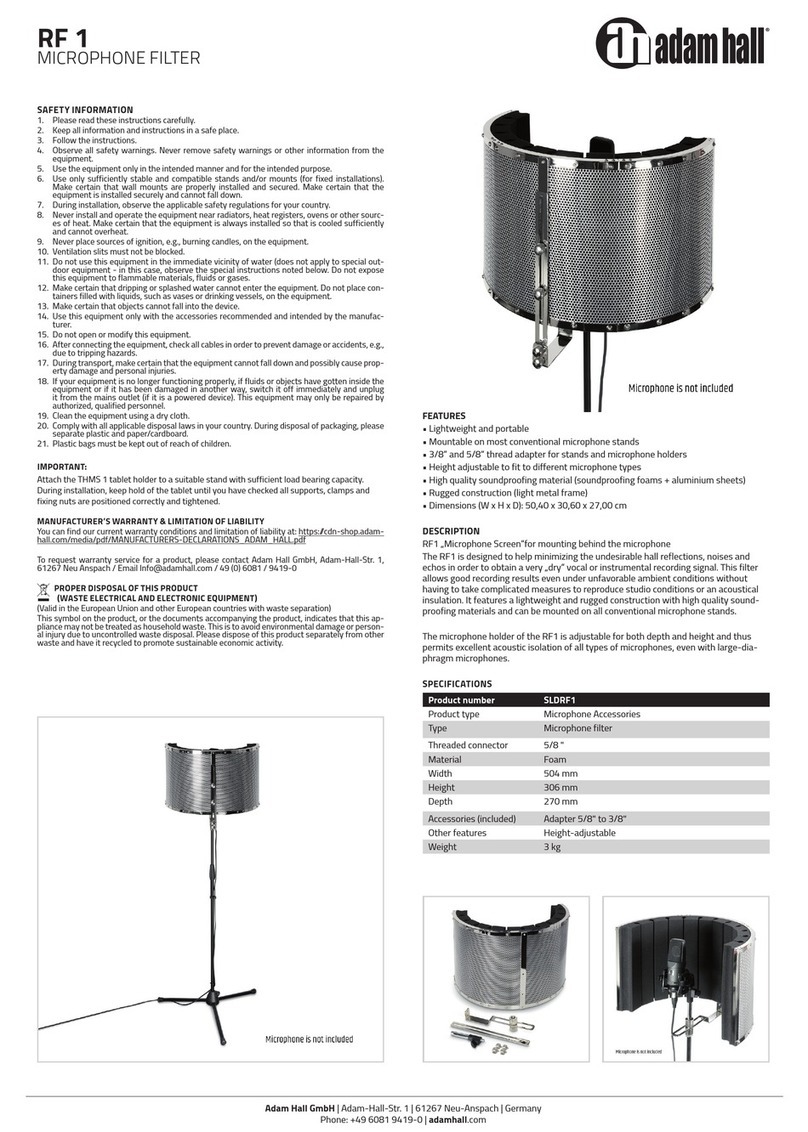
Adam Hall
Adam Hall SLDRF1 manual
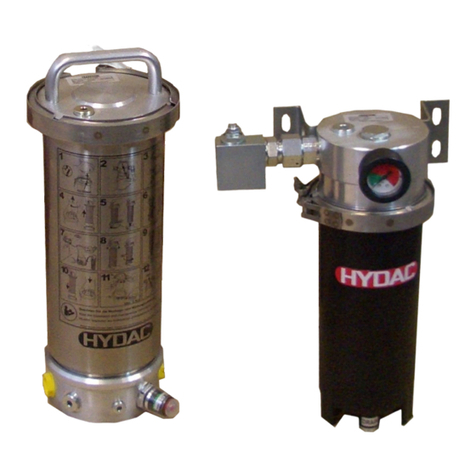
HYDAC FILTER SYSTEMS
HYDAC FILTER SYSTEMS OLF-5/Z Installation and maintenance instructions
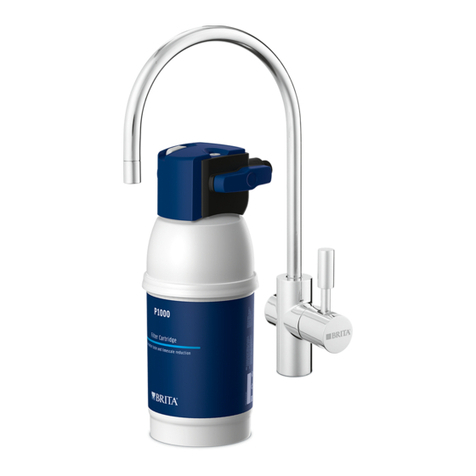
Brita
Brita mypure P1 Instructions for use
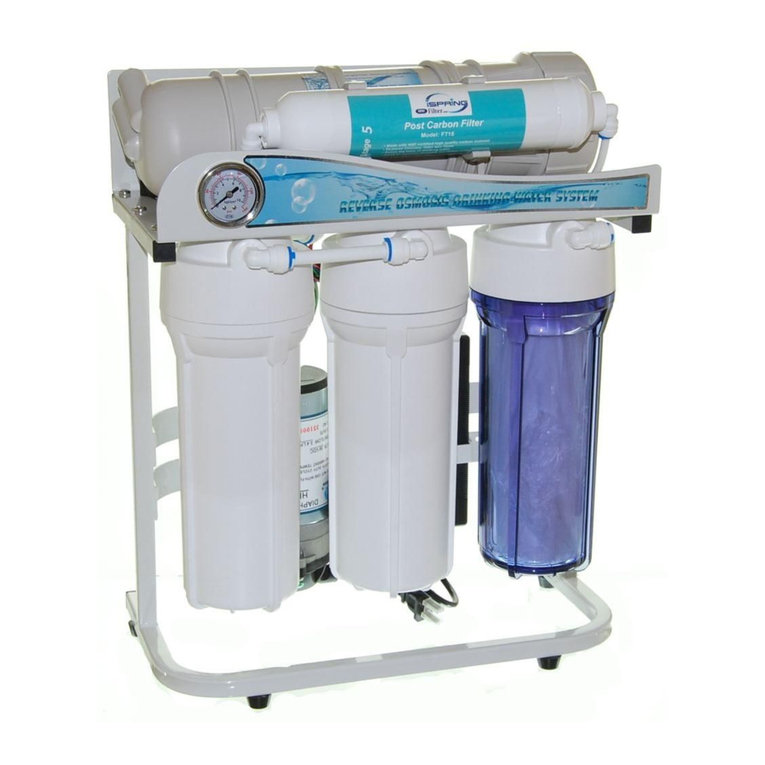
Ispring
Ispring RCS5T Installation instructions & user manual
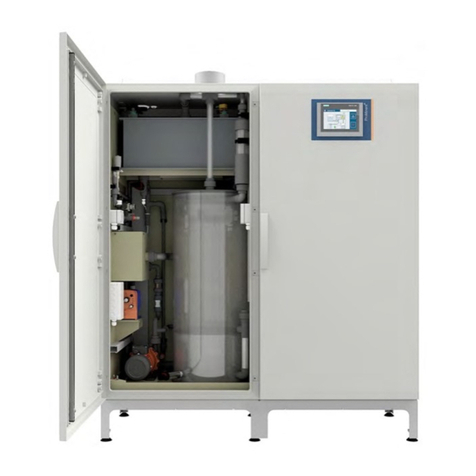
ProMinent
ProMinent CHLORINSITU IIa 625 Maintenance instructions
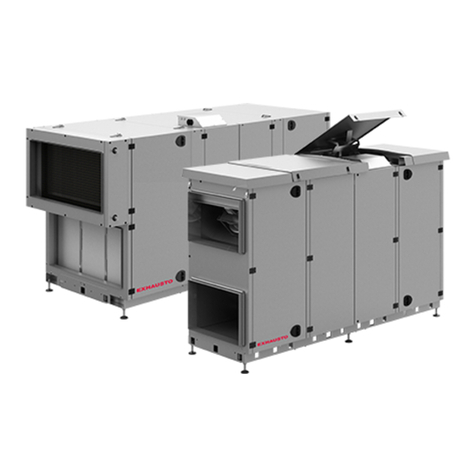
Exhausto
Exhausto VEX350 manual
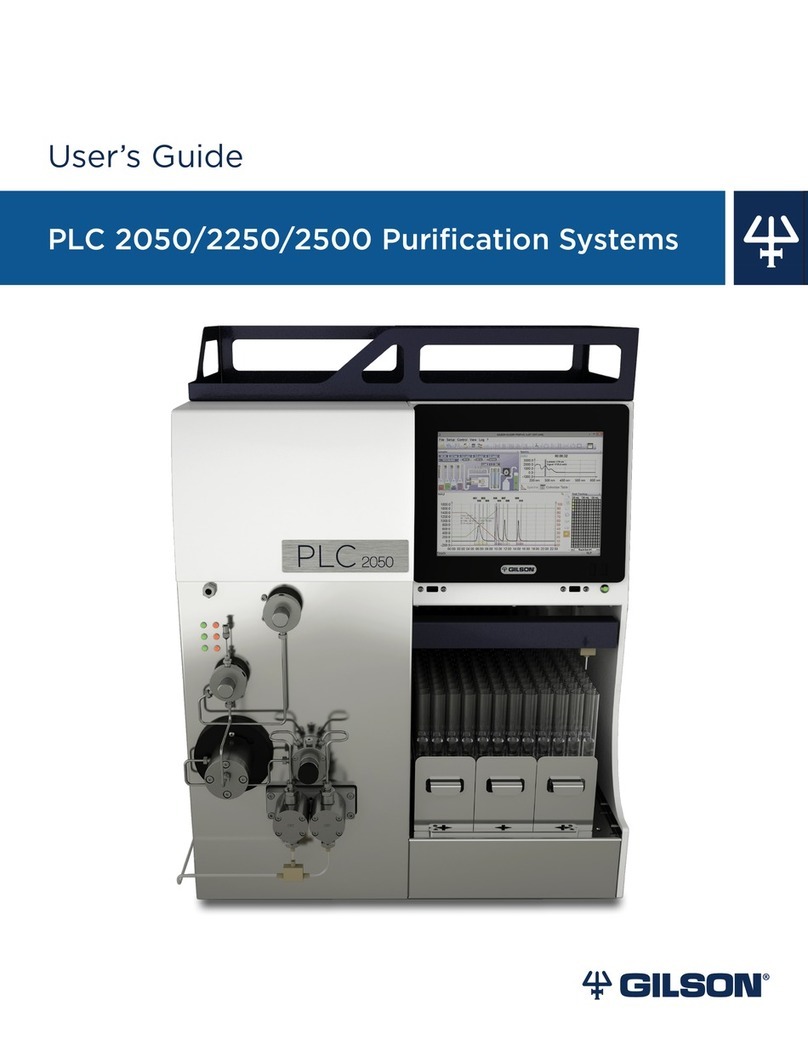
Gilson
Gilson PLC 2050 user guide
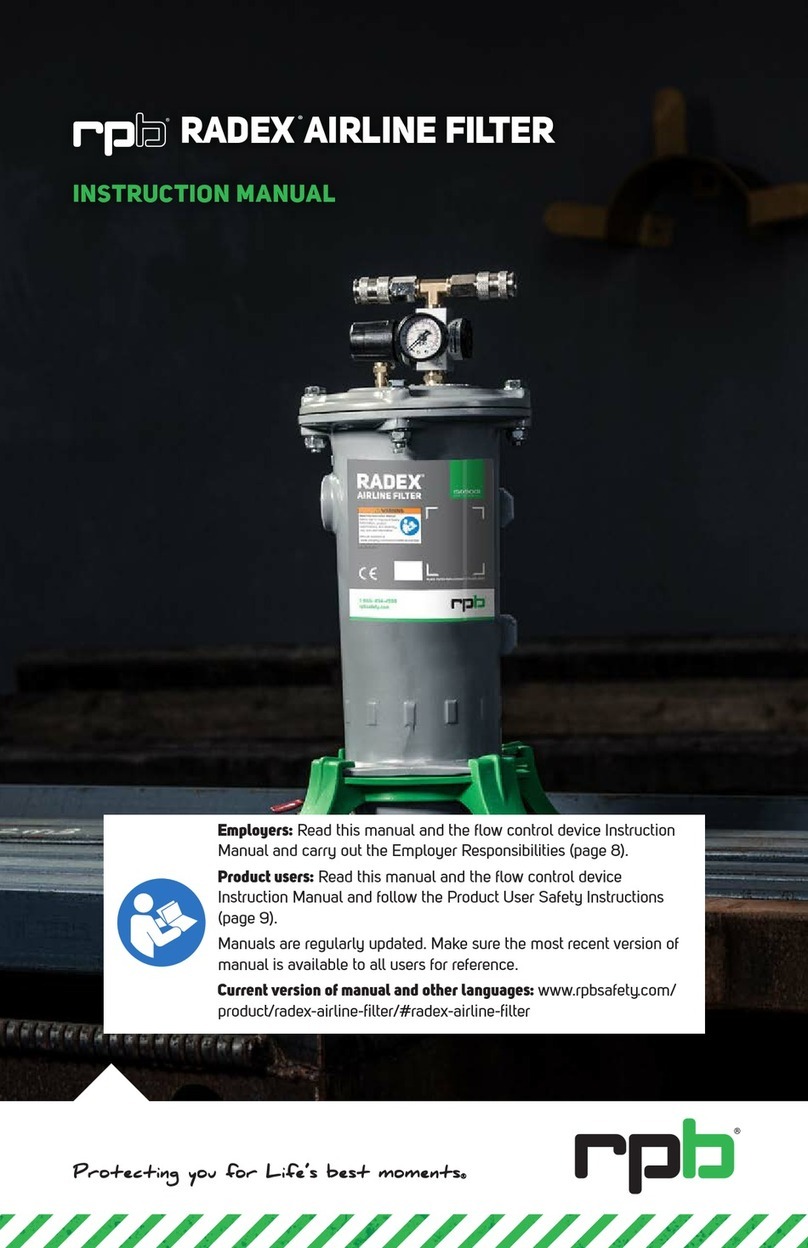
RPB
RPB RADEX AIRLINE FILTER instruction manual

WaterGroup
WaterGroup HTO-185HEUF owner's manual
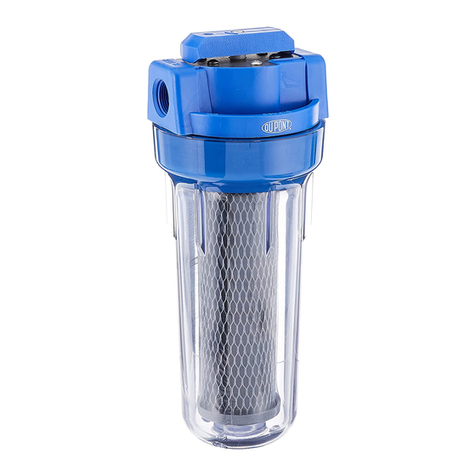
Du Pont
Du Pont WFPF3800 Series installation instructions
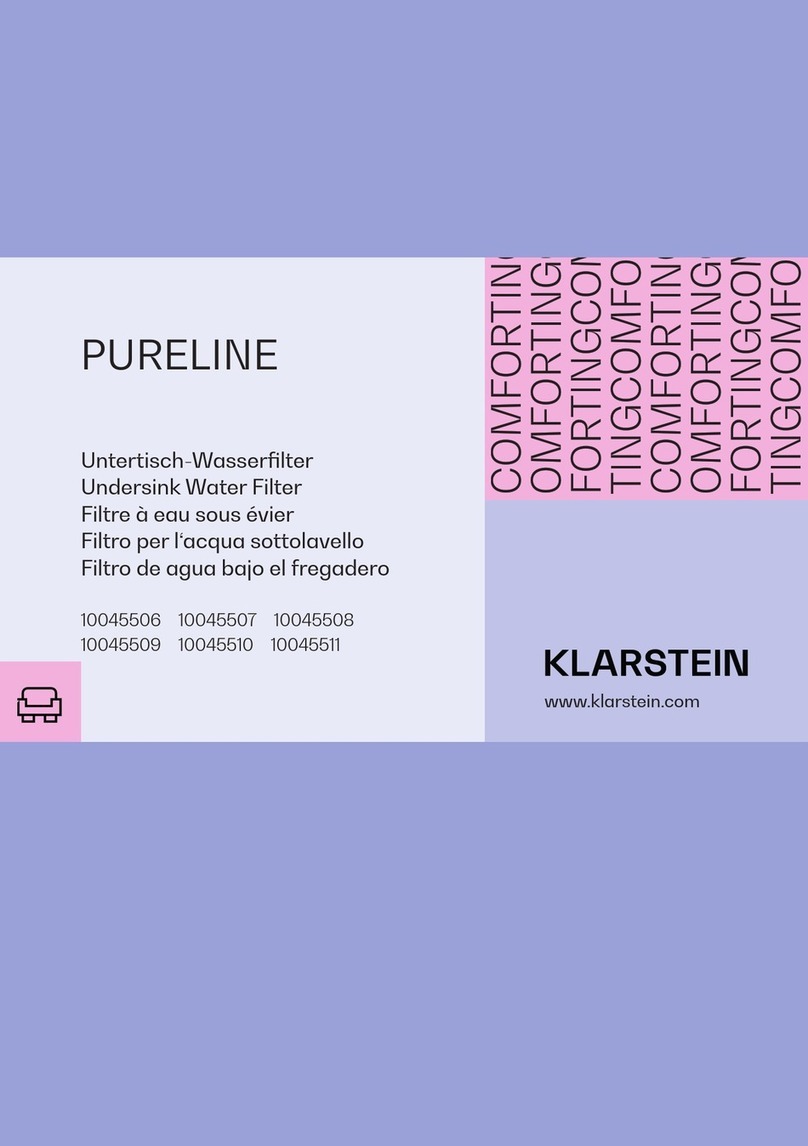
Klarstein
Klarstein PURELINE manual
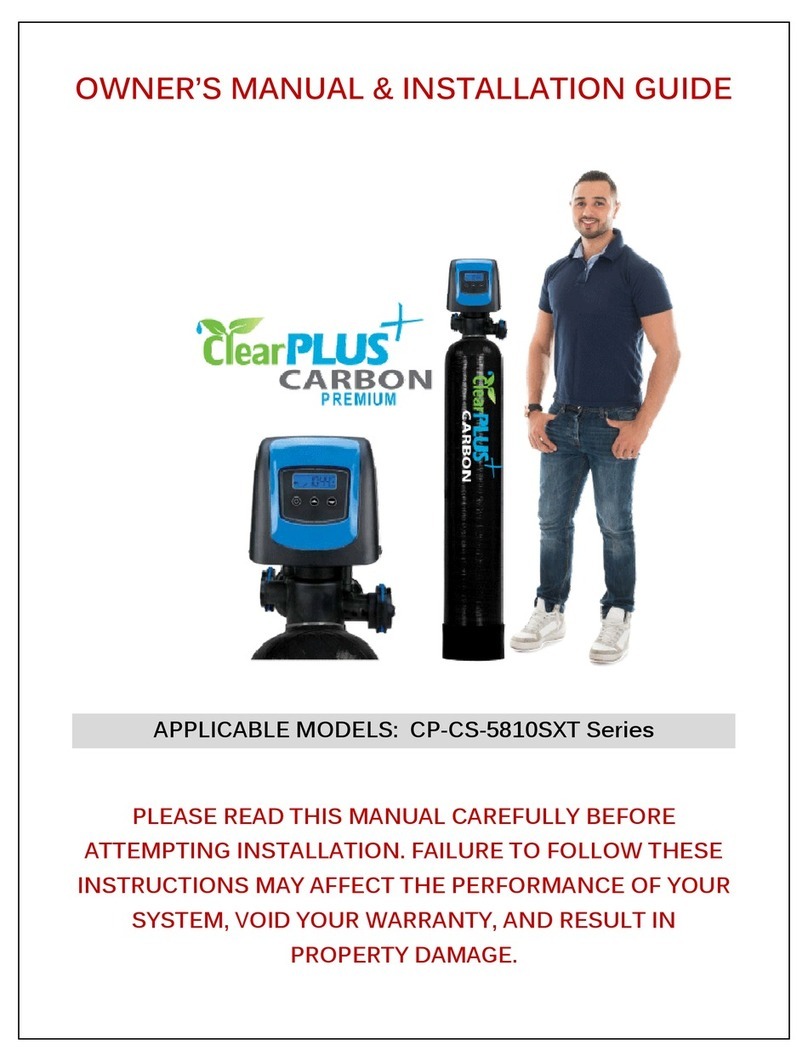
ClearPlus
ClearPlus Carbon Premium CP-CS-5810SXT Series Owner's manual & installation guide
